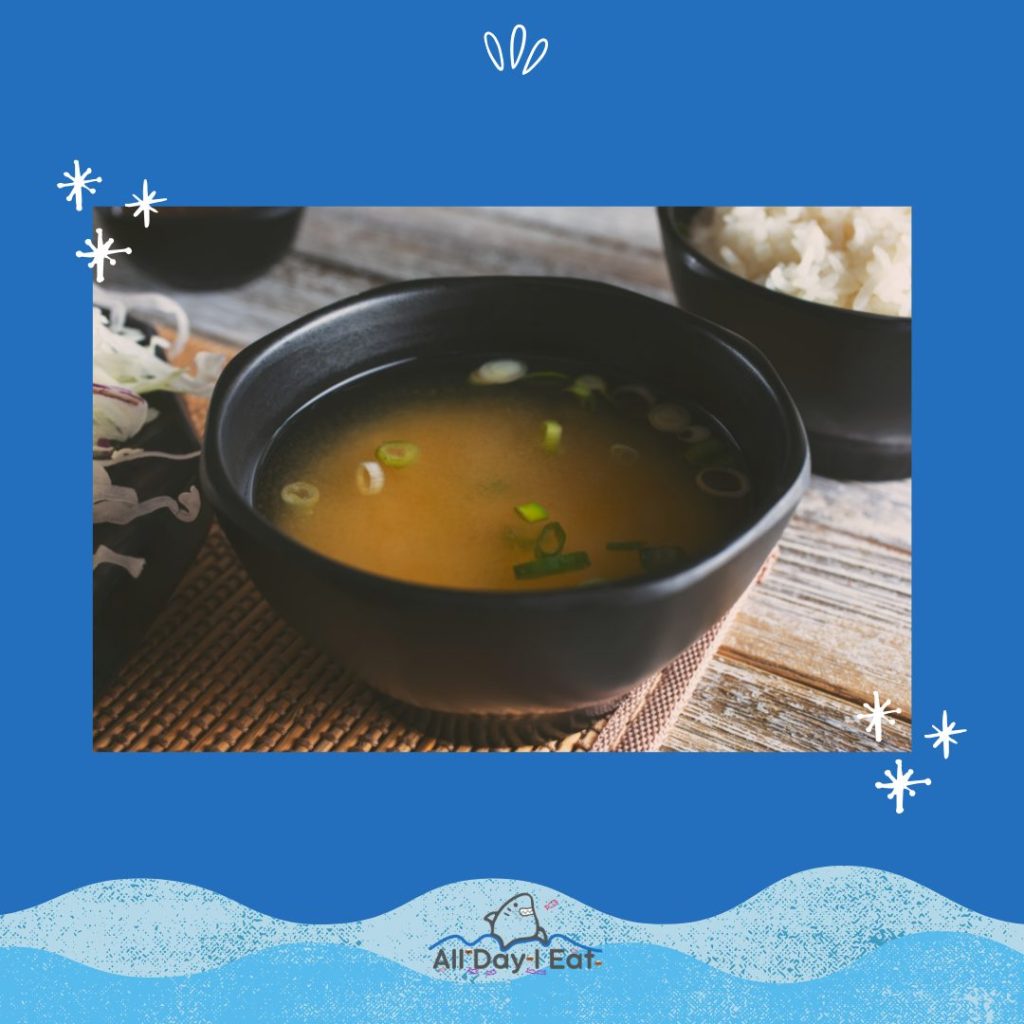Can a miso soup go bad and keep you from enjoying this delicious traditional Japanese dish packed with health benefits?
While It is made from fermented soybeans and contains essential nutrients like protein, fiber, vitamins, and minerals, your miso soup can still go bad. In this article, we’ll explore the signs of spoiled miso soup and how to store and handle it to extend its shelf life properly.
By following these tips, you can ensure your miso soup stays fresh and safe to enjoy. So, let’s dive in and learn about keeping your favorite soup at its best!
Key Takeaways

- Miso soup can spoil if it has a sour smell or taste, unpleasant odor, changes in color, or mold-like spots. Prompt disposal is necessary in such cases.
- To extend the shelf life of miso soup, store it in an airtight container and promptly refrigerate it at 40°F (4°C). Leaving it at room temperature for too long should be avoided.
- Common mistakes that can lead to spoiled miso soup include leaving it at room temperature for too long, using dirty utensils, improper storage, and not refrigerating promptly after cooking or serving.
- Proper handling and preparation of miso soup involve using clean utensils, storing leftovers in an airtight container, following recipes, and adding ingredients like tofu, seaweed, or mushrooms. Enjoying miso soup could be part of your healthy diet.
Did Your Miso Soup Go Bad?

If the miso soup has a sour smell or taste, it’s likely gone bad. Consuming expired miso can pose health risks to you and those you serve. Therefore, be aware of signs that indicate spoiled miso soup to ensure your safety.
Expired miso may have a strong, unpleasant odor, indicating bacterial growth or fermentation gone awry. Additionally, the color of the soup may change from its usual rich brown to a darker shade or even develop mold-like spots. These visual cues indicate that the miso has deteriorated and should not be consumed.
To prevent any potential health issues associated with consuming spoiled miso soup, discard any batches that show these signs.
Shelf Life and Storage of Miso Soup

You can extend its shelf life by storing it properly. Follow these guidelines to ensure your miso soup stays fresh and flavorful for as long as possible.
- First, always refrigerate leftover miso soup promptly after cooking or serving.
- Store it in an airtight container to prevent the absorption of odors from other foods in the fridge. The proper storage temperature should be around 40°F (4°C).
- Avoid leaving miso soup at room temperature for too long, as this can promote bacterial growth and spoilage.
Following these storage tips, you can enjoy delicious miso soups while reaping their health benefits.
Common Mistakes That Can Lead to Spoiled Miso Soup

Refrigerating leftover miso soup promptly after cooking or serving can help extend its shelf life and prevent spoilage. To ensure that your miso soup stays fresh and delicious, avoid these common mistakes:
1. Leaving it at room temperature for too long
Miso soup should not sit out for more than two hours. Bacteria can multiply rapidly in warm temperatures, leading to the spoilage of the soup.
2. Not using clean utensils
Using dirty spoons or ladles when serving miso soup can introduce contaminants that may cause it to spoil faster. Always make sure to use clean utensils when handling food.
3. Storing it improperly
Miso soup should be stored in an airtight container in the refrigerator. This helps maintain its freshness and prevents any cross-contamination with other foods.
Proper Handling and Preparation of Miso Soup

To properly handle and prepare miso soup, use clean utensils, store them in an airtight container, and refrigerate.
To make your miso soup at home, you can follow various recipes that include ingredients like tofu, seaweed, mushrooms, or vegetables. When handling miso paste for the soup base, use a clean spoon or spatula to avoid contamination.
After preparing the soup, store any leftovers in an airtight container in the refrigerator to keep it fresh for longer.
How to Extend the Shelf Life of Miso Soup

If you want to extend the shelf life of your miso soup, ensure that it is stored in an airtight container and kept in the refrigerator. Here are three ways to make the most out of your miso paste and create different types of miso soup recipes:
1. Experiment with ingredients
Use miso paste as a base to create unique flavor profiles by adding vegetables like mushrooms, seaweed, or tofu. You can also try incorporating noodles or rice for a heartier option.
2. Customize seasoning
Adjust the flavor of your miso soup by experimenting with different types of miso paste – white, red, or mixed. Each type offers its distinct taste and richness.

Konnichiwa! (Hello!) I'm Pat Tokuyama, a Japanese tofu cookbook author, who travels for music, food, and adventure. If you like Japanese tea, checkout some of the newestorganic japanese tea, matcha bowls and noren and more!
** Curious about the Plant Based Japanese Cooking Club? ** Learn more here!
3. Add variety to your toppings
Enhance the texture and taste of your miso soup by topping it with scallions, sesame seeds, or even crispy bacon bits for added depth and crunch.
Conclusion
Did your miso soup go bad? Knowing the signs of spoiled miso soup is important. You can extend its shelf life by avoiding common mistakes and following proper handling and preparation techniques. Properly storing and handling miso soup is crucial. Remember to always check for any changes in smell, texture, or appearance before consuming miso soup. These are indicators that it may have gone bad.








Konnichiwa! (Hello!) I'm Pat Tokuyama, a Japanese tofu cookbook author, who travels for music, food, and adventure. If you like Japanese tea, checkout some of the newestorganic japanese tea, matcha bowls and noren and more!
** Curious about the Plant Based Japanese Cooking Club? ** Learn more here!